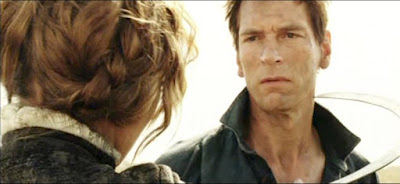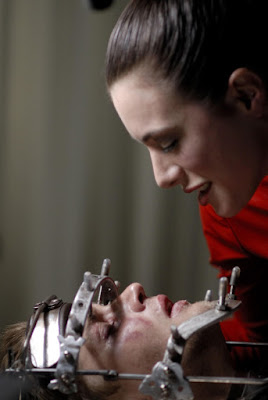Although it has its share of contrivances (boy, howdy, does it!), Adam Green's Frozen (2010) turns the screws about as tight as any movie I've seen this month. I'm kind of gobsmacked by this, actually, given that I hated, hated, hated Green's Hatchet and given that when I heard the premise of this movie, concerning a trio of snotty bourgeoisie college kids (played well by Emma Bell, Kevin Zeggers, and Shawn Ashmore, who are better than the characters with which they've been provided) trapped on a ski lift, I wondered about the terror potential of the situation it creates. This turns out to be one of the nastier horror movies I've seen recently, and bully for that. It's always nice to know that one isn't so jaded with horror movies that a really brutal one can't work one over (but good).
Anyway, this concerns three skiers who have wheedled their way onto the lift for one last run down the mountain in such a way that no one knows they're there. When the lift is stopped, they're basically screwed because it's the last run of the week, a bad storm is moving in, and none of them has a cell phone. So, yeah, it's bad, but by the 45 minute mark, I started to wonder how they could milk any more suspense (or, indeed, any actual horror) out of the situation. Silly, me. This one goes for the throat once one of our intrepid skiers jumps from the lift and breaks both his legs. And then the wolves come. And frostbite. The singlemindedness with which this examines its premise makes me rather forgive the contortions it goes through to set up its situation. Most movies start well, then go downhill. This one gets noticeably better as it unfolds.
This movie is unusually good at the gross-out, from compound fractures to the singular effect of a hand freezing to a metal bar. This put its finger on a raw nerve I didn't even realize was exposed. Bravo. But it does more than gross the audience out. Like most good genre pieces, this acts as a crucible to examine its characters. While the characters here aren't particularly interesting, the movie manages to connect with their humanity, which is something I might have though beyond Green (again, on the evidence of Hatchet). The film's best scene, and the one I'll take away from it even more than it's thoroughly nasty grue, finds the female member of our cast wondering who'll take care of her puppy in her absence only to realize that it will starve to death because no one will know that she's missing. This scene doesn't rely on any of the characters' bland backstories for the audience to plug into a shared experience. It works wonders on the movie, because prior to this scene, I didn't much sympathize with our heroes. It also suggests that the director has more to say beyond a desire to make horror movies, and that's an ambition that many genre directors never come to. Good for him.
Current Challenge tally:
Total Viewings: 31
First Time Viewings: 31




















































